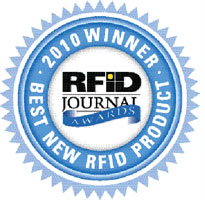Jun 01, 2010On Apr. 19, 2010, RFID Journal presented the fourth annual RFID Journal Awards for outstanding achievement in radio frequency identification technology to four companies at RFID Journal LIVE! 2010, our eighth annual conference and exhibition. This year's winner for Best New RFID Product was Impinj.
To boost read rates, all four Monza 4 chips—the 4D, 4E, 4U and 4QT—rely on the company's True3D architecture. That means each chip has two radios that attach to separate antennas on the tag, so the tag can be read regardless of its orientation. The four chips each offer different user and EPC memory, to suit a wide variety of applications—from taking inventory in retail stores to tracking airline baggage and cartons in the supply chain.
The Monza 4QT chip also has a unique set of features to restrict access to any business-sensitive or personal data stored on the tag. To protect the confidentially of the information encoded to a tag, the 4QT chip supports two data modes: In "private" mode, designed for a company's internal use, anyone can read all the data on the chip; in "public" mode, only a generic serial number can be read. The user can instruct the tag to operate in either mode, by means of a simple password-protected command from the interrogator.
So, for example, a manufacturer could set the tag to private mode to track work-in-process. Before packaging the item for distribution, the manufacturer could switch the tag to public mode to prevent a potential thief from identifying the product. A retailer might want to set the tag back to private to authenticate the product but switch it to public after the item is purchased, to protect consumer privacy. The tag could be set back to private to make warranty information accessible.
A "peek" feature ensures that a user who temporarily switches a public tag to private to access the information doesn't inadvertently leave the tag in private mode, exposing confidential data to unauthorized users. When the chip loses power, it automatically reverts to public mode.


